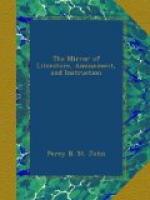The engravings are somewhat more numerous than usual; in all numbering sixty-three; and they are accompanied by illustrative letter-press of concise, but we trust, entertaining character.
In Popular Antiquities we may mention Old Fishmongers’ Hall, which has disappeared since the date of our last volume; the Castles of Pontefract, Wilton, and Dunheved, with traits of their historic lore; the Lady Chapel, in Southwark, and its changing history; Brighton about a hundred years since; the Arbalest, or Cross-bow explained with Cuts; Old Bankside, and the First Theatres; the venerable Melrose on the Tweed; St. Pancras (Old) Church; and the castellated palace of the Alhambra, in Spain.
Among the Architectural novelties are the Law Institution, in Chancery Lane; the Lowther Arcade, in the Strand; Staines New Bridge; and two scenes of the picturesque wonders of the Colosseum, in the Regent’s Park.
In Zoology, the most popular study of the day, there are upwards of a score of novelties. Among them are a dozen Vignettes from the Zoological Gardens in the Regent’s Park, and in Surrey; and illustrations of Rare Arctic Birds observed during the last overland expedition to the Polar Sea, by Captain Sir John Franklin.
In the ensuing volume, we have determined upon enlarging our letter-press page; whilst a new and handsome type has been cast expressly for this work. By these improvements, as well as by the renewed vigour of our artists, and a like zeal on our own part, the mirror will be found still worthy of its old friends, and attractive to new patrons. Its economy need not be again enforced, although in this respect, our contemplated alterations cannot but be received as additional points for the encouragement of a discerning public.
London, June 28, 1832.
* * * * *
MEMOIR OF THE RIGHT HON. CHARLES GREY, EARL GREY, K.G.,
First lord of his majesty’s treasury, &c. &c.
* * * * *
De Bon VOULOIR SERVIR Le Roi.—Family Motto.
* * * * *
The family of Grey—the Greys of the North, as they are styled distinctively from the Greys of the South,[1]—is of Saxon origin.[2] They have held manors in Northumberland from the earliest records to the present time. The direct founder of the present branch was Baron Grey of Werke, ennobled by James I. and advanced to the earldom of Tankerville by William III. which titles became extinct in 1710; and the heiress carried the estates by marriage to Charles Bennet, Lord Ossulston, who was, in consequence, created Earl of Tankerville, in 1714.
[1] Wilton Castle, on the
Wye, was for several centuries the
baronial
residence of the Greys of the South, who derived
from
it their first title, and became its owners in the
time
of
Edward I.—See Mirror, vol. xiv. p.
305.




